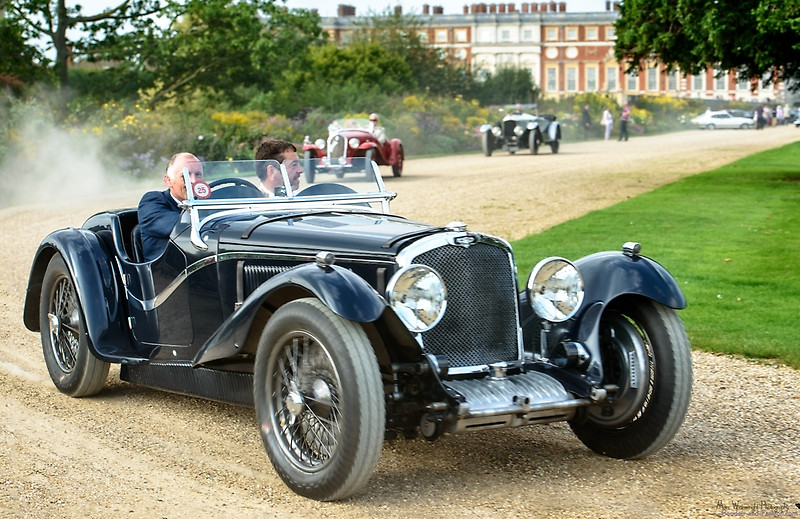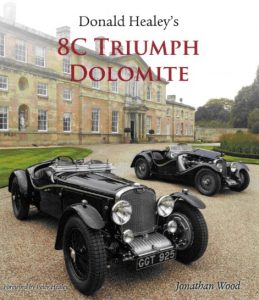
1935 Triumph 8C Dolomite: The Big One….Is Back
Jonathan Wood, Donald Healey’s 8C Triumph Dolomite. Wetherby, Yorkshire: Jonathan Turner & Tim Whitworth, 2017, 300 pages, profusely illustrated in color and b&w, $275. Available from the publishers. Written for The Vintage Triumph Register.
Donald Healey’s Dolomite
In 1977 I wrote the pre-World War II chapters of Triumph Cars, now reappearing in an expanded new edition, thanks largely to my co-author Graham Robson (blatant plug, please order).
At the time, though, there was little to describe about Triumph’s most impressive failure, the legendary straight-eight Dolomite. The only one built by the factory had come to grief (along, almost, with Donald Healey) at a railway crossing on the 1935 Monte Carlo Rallye. Donald of course contributed what he knew, and we put in what we gleaned from contemporary press reports and factory documents. All we could conclude was that that a car with so much promise remained “The Big One That Got Away.”
 Graham soon helped us to learn more. Prominent collectors restored both Dolomites. Now, Jonathan Wood produces The Big One’s history. Here is a legend none of us will ever own, only two of which were built, only one by Triumph. (There were three chassis, and parts for six engines.) The book exists through the efforts of the two current Dolomite owners. Anyone who loves Triumphs will be grateful to both publishers and author.
Graham soon helped us to learn more. Prominent collectors restored both Dolomites. Now, Jonathan Wood produces The Big One’s history. Here is a legend none of us will ever own, only two of which were built, only one by Triumph. (There were three chassis, and parts for six engines.) The book exists through the efforts of the two current Dolomite owners. Anyone who loves Triumphs will be grateful to both publishers and author.
The straight-eight Dolomite was the prewar company’s finest hour. Never again would there be a Triumph like it. In its time, a two-liter car that could do 110 mph bid fair to be the quickest touring sports car in England. It was a Triumph in the generic as well as the specific sense. Driving it was to experience the classic prewar English sports car in its most highly developed form. It was a Donald Healey masterpiece.
Dolomite lore
False stories about the Dolomite circulated for years. Some said Triumph built six, maybe eight. We heard of sedans and coupes. An old fellow had one in a barn but wouldn’t let anyone see it. Alfa Romeo sued Triumph for copying their 8C 2300 roadster. (Reminds me of Churchill’s supposed peace offers to Mussolini in World War II. They’re in a waterproof bag at the bottom of Lake Como, and if you can’t find them you just haven’t looked hard enough.)
Jonathan Wood has looked hard enough. He puts paid to all those rumors. He delivers exhaustive details on both cars—one built by the works, one from parts. Nothing escapes his net. The result is a cleanly designed 10×12” coffee table book, laden with large-format illustrations and authoritative text.
Methodically, Wood conducts the narrative. The prelude is 1931 when Bentley, Britain’s premier sporting car, stopped racing and entered receivership. Several companies vied to fill the void: Riley, MG, Squire. At Triumph, experimental manager Donald Healey was taking a look, encouraged by auto writer Tommy Wisdom. Their eyes fell upon Vittorio Jano’s Alfa Romeo 8C 2300, one of the most beautiful prewar sports cars. It was the Dolomite’s inspiration.
Triumph’s saga
The prelude spans eighty pages of Triumph history: origins of the company under Siegfried Bettmann, its revival under Claude Holbrook, its impressive rallying successes; its lovely production cars, like the Gloria and Southern Cross. Plentiful illustrations include maps showing one-time works locations.
The Dolomite was styled by Triumph body engineer Frank Warner. Who was Frank Warner? In one of his extensive sidebars, Wood provides Frank’s life story. Likewise Bettmann, Holbrook, Wisdom, Jano, designer Walter Belgrove, and of course the great Donald Healey.
The straight-eight program officially ended in April 1935, but in Triumph Cars we showed a 1936 advert for a “very special ‘Continental’ sports saloon” related to it. Jonathan Wood has tracked that story down too. This beautiful long wheelbase saloon by Walter Belgrove (since vanished) was part of an extended line of cars planned around the Dolomite’s Alfa-like double overhead cam straight eight engine. Walter Belgrove’s renderings of a body styles show what could have been “Triumph’s flagship line.”
Recent History
We next delve into the Dolomite’s subsequent history: Tony Rolt’s and Robert Arbuthnot’s acquisitions of Healey’s car, rebuilt after its collision; parts sufficient for a second complete car; the racing career of the rebadged HSM (High Speed Motors); Giulio Ramponi, whose Corsica body betimes graced a chassis. Profuse photos show both cars in their various guises and appearances through the years. The best of these are double page color portraits of both cars today, restored to perfection. The endpapers of the book are color close-ups of their beautiful engines.
The last third of the book is a chronological, account of the history and known ownership both cars: DMH1 (Donald Healey’s, now owned by Jonathan Turner), and DMH2 (Tony Rolt’s ex-HSM, now owned by Tim Whitworth). It is amazing how many people actually knew about the cars over the years; it took Wood to put their tale together.
Wood reprints driving impressions from 1935 on, but Patrick Blakeney-Edwards, who restored DMH1, probably knows the Dolomite as intimately as anyone. “On the road it just feels fantastically competent,” he says—“it’s as good as any prewar car I’ve driven. The brakes are stupendous, the steering light and the ride excellent. It’s perfect for unstressed high-speed motoring….For me it feels as though it was built for competition, particularly around a circuit such as Le Mans….”
Above all this book is a tribute to Donald Healey, whose grandson Peter contributes the Foreword. Writing Triumph Cars, I had the fun of knowing him, and bugging him about his years with the company. An advanced autoholic, Donald liked nothing more than reliving old times, the good, the bad and the ugly. A kinder, more generous and talented man never existed. He’d love this book.






